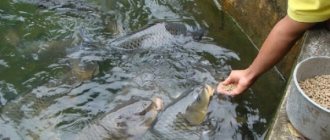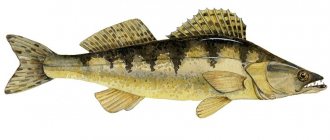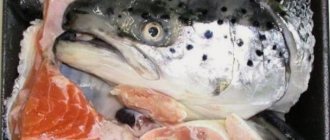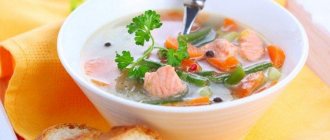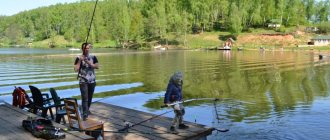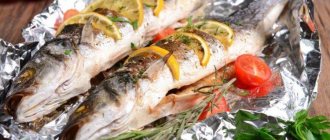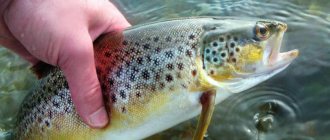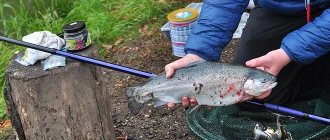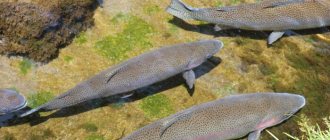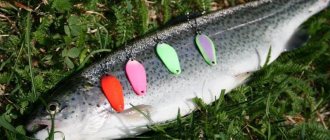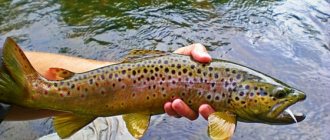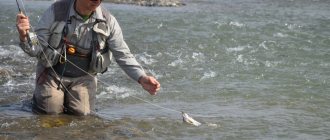Delicacy fish, inaccessible to ordinary fisherman, is always in demand and highly valued on the market. One of these is trout. In stores, the cost of this type of salmon can reach almost a thousand rubles per kilogram. And therefore, raising trout in a pond is a good way to make money. This fact is confirmed by experienced farmers who receive a tidy sum from this business. However, trout farming initially requires considerable costs, great effort and responsibility. All this will quickly pay off if you approach this business wisely.
A little about trout
In total, 20 species of these salmon fish are known. Only two high-yielding trout are usually bred for sale. These are rainbow (mykiss) and brook (pied). Their growth rate and fertility are almost 40% higher compared to other trout fish. It is worth saying that both species are predatory, which is reflected in their feeding diet. They feed on small frogs, bugs, dragonflies and such fish as verkhovka, minnow and ide. This feature must be taken into account before starting trout breeding in a pond as a business.
Brook trout
This species lives in cold waters that flow into the Black, Baltic and Caspian seas. Typically, in natural conditions, adults reach 12 kg. But in artificial reservoirs such results can be achieved with considerable effort. To breed, you need to be patient: fish will not spawn for the first few years if you purchase them as fry.
The average lifespan of brook trout is 12 years. In the first year, fish will weigh 20-25 grams, two-year-olds - 130-170 grams, and in the 3rd year - half a kilogram. The fertility of this trout depends on the weight of the female, which is why you can find such a wide spread from 2 to 15 hundred eggs. The fish will begin to spawn no earlier than the 3-4th year of its life. Incubation of eggs usually occurs in the fall, when the water temperature rises to 2-8 degrees.
Biological description
Trout belongs to the salmon family. It has an elongated but laterally flattened body and a short muzzle. The average length of an adult is 25-30 cm. It weighs between 200-500 grams, although there are specimens weighing 1, 2 and even 5 kilograms.
Males are smaller than females, but have more teeth. There are 2 fins clearly visible on the back, one of which is false.
The color of the fish is unstable and depends on the color of the bottom, the state of the water, and the diet. The colors are predominantly greenish on the back, turning to off-white, sometimes with a copper tint along the belly. In water bodies with a light bottom, trout are most often silver with small black spots.
If the bottom is dark and muddy, then the color is darker. There are species in which the back is completely black, while the abdomen is brown. No matter what colors they have, there are always multi-colored specks on the body.
The word trout hides not one, but several species of salmon fish.
The most famous types of trout are:
- rainbow;
- stream;
- lake
Rainbow trout
This species got its name due to its beautiful iridescent scales. Rainbow trout appeared in North America, and in Russia they began to be cultivated quite recently. These fish grow better than stream fish and tolerate low temperatures well. This is what attracts the attention of businessmen to rainbow trout. Breeding in a pond is still best done in warm water (16-18 degrees). At this temperature, good growth will be guaranteed.
Fish become sexually mature after 2-3 years. Females, depending on age, are capable of producing from 8 to 30 hundred eggs. Their incubation usually occurs in the spring. Rainbow trout fry weigh up to 30 grams, one-year-olds weigh 100-125 grams, and at 2 years old they weigh up to 200 grams. The difficulty in breeding mykiss is that it is very difficult to stimulate reproduction. Most often they resort to artificial insemination. Just in case, farmers play it safe and purchase both species for breeding: rainbow and brook trout.
Growing cycle and technology
Growing trout takes quite a long time. In order for the fry to grow to the size of an adult fish within a few years, it is necessary to create suitable conditions. The equipment used for trout farming is also suitable for other types of fish. The difference lies in the unique conditions. To do this, it is recommended to first study the features of the natural environment in which the trout lives.
Suitable water chemistry for keeping trout includes the following standards:
- oxygen level - from 7 to 11 milligrams per liter (the necessary indicator will be provided by the aeration column);
- pH value – not lower than 6.5 and not higher than 8 (if it falls below the permissible norm, the fish stops reproducing; if it rises higher, the trout may die);
- nitrate concentration – up to 100 milligrams per liter (above this value poses a risk to fish);
- ammonia level - 0.1 milligrams per liter;
- hardness index – from 8 to 12;
- carbon dioxide content – up to 35 milligrams per liter;
- chlorine level – up to 0.01 milligrams per liter.
To check chemical indicators, special devices are used, which can be purchased at hardware stores.
Feeding fry and adult fish
Proper feeding determines how long it will take for the fry to grow to the size of an adult, and how tasty the fish will be. There are two types of trout food: organic and dry. Fish tastes better if the first type is used.
To give fish meat a red color, canthaxanthin should be added to the food.
Feeding of fry and adult fish is different. You should start feeding trout from the moment it is born. The diet for fry consists of:
- zooplankton (egg yolk may be added);
- meat and fish flour;
- fish oil.
You can prepare a mash by combining different feed options. The optimal number of feedings per day should not exceed 9 times. A thousand individuals require about 90 grams of food. There is a special floating and sinking type food available for sale that simplifies feeding.
Adults can be given dry and live food. The ratio of these species is divided approximately equally with a bias in favor of living species. The diet for adult fish consists of:
- chopped animal meat;
- fish waste;
- shrimp;
- water snails;
- insects
Fiber is also used to feed fish. It does not provide any benefit to the trout, but it loosens other types of food, making them better digestible.
Temperature
In a body of natural origin, it is difficult to regulate the temperature. Therefore, it is recommended to keep trout in a RAS. Depending on the age, the following indicators are suitable for this type of fish:
- from +6 to +12 degrees Celsius – for the ripening of caviar;
- from +10 to +14 degrees Celsius – for fry;
- from +14 to +16 degrees Celsius – for adult fish.
The temperature gradually rises as the trout grow.
Care and cultivation standards
In order for trout to develop well, you need to follow a number of tips. The water must have the right temperature and sufficient oxygen. It is necessary to check the serviceability of filters - water contamination can harm the fish.
It is recommended to separate small and large fish by placing them in separate containers. Thanks to this method, weak individuals will get more food and they will grow faster. During the spawning period, the best individuals should be selected to produce offspring.
With normal development, the weight of rainbow trout is:
- 30 grams – at the age of fry;
- 125 grams – one-year-old individuals;
- 200 grams – fish over two years old.
Brown trout develop more slowly, so the indicated indicators for it are lower at the same age.
Starting a trout business
Where to start breeding trout in a pond? The first step is to visit existing farms and see how the farm is organized and the work is structured. Experienced trout breeders will be happy to share the nuances and subtleties of this business. At the same time, you can look for your future suppliers of fry or adults. Better pay attention to farms that stand on their own feet. They will not only sell fish, but also give competent recommendations. After this, it’s time to think about the breeding location and purchasing the necessary equipment. By the way, in some cases it will not be cheap.
If after this the desire to breed trout has not disappeared, then feel free to go to the tax service. The future enterprise can be registered as an individual entrepreneurship. The OKEVD code must be selected “05.02” - this is fish farming, which is suitable for raising salmon for subsequent sale.
As soon as the paperwork is over, you can purchase everything you need and look for clients. And after trout becomes available for sale, it’s worth getting acquainted with the employees of the sanitary and epidemiological station. Every fish farmer is simply obliged to obtain an opinion on the proper quality of the product.
open pond
It is believed that this is the most unprofitable and inconvenient method of breeding. To raise trout, you will need to find an already functioning pond or build one yourself. At very low temperatures, both mykiss and damselfish will grow poorly and will take at least 5 years to be sold. For this reason, breeding trout in a pond in winter is simply impossible.
Catching fish from open water for subsequent fertilization or sale is not an easy task. To carry it out, they usually hire experienced specialists who charge a tidy sum for their work. There is also a high probability of disease and theft of trout by local poachers. And treatment and security guards are additional expenses.
cages
This method of breeding differs from the first only in that some part of the open reservoir is fenced off. The boundaries are cages - metal gratings or nets on stakes, inside of which the farmed fish are placed. Since only part of the reservoir is used for trout breeding, paid fishing for amateurs can be organized on the remaining area. Another plus is that it is much easier to monitor part of a reservoir than a whole lake. For these reasons, fish farmers believe that cage farming of trout in a pond is a more profitable business.
However, due to the dense stocking of fish and active feeding, the problem of pollution of the reservoir will be acute. It will constantly need to be cleaned. Because of this, trout cannot be raised in ponds with drinking water.
Automated trout feeding
Figure 1: Feeding device used in trout production. Several types of automatic and mechanical feeders are available for trout farming, including electric ones with timers. There are feeders that use compressed air to blow through the surface of the water at set intervals, as well as truck or trailer mounted units that have hydraulic air delivery devices.
By carefully setting trout feeders, rapid weight gain and efficient feed utilization can be achieved. The use of food feeders can eliminate the sudden decrease in oxygen that occurs when fish are fed by hand or machine several times a day. Food feeders also reduce the labor costs associated with daily manual feeding. Disadvantages include a tendency to overfeed due to improper feed adjustments and food output only in a small part of the pond or tank. Overloading feed with nutritional demand can be a problem with large trout.
Food feeders should be located at intervals of 1 meter along the walls of the tank. After a few days the feed can be added, but for best feeding efficiency it should not be replaced until the feeding period has passed. Adjust the feeder. Even if food feeders are used, feeding according to the feed chart is recommended for best performance. Whether fed by hand or using a mechanical distribution system, the feed should be distributed throughout the entire pond and should not accumulate on the bottom. In concrete tanks, trout will feed on some of the pellets that fall to the bottom, but trout rarely pick up pellets from the bottom of ponds.
Artificial pond
For both large and small volumes of fish, installing an artificial closed pond is an excellent option. Moreover, you can place it directly indoors at your dacha or in a rented warehouse. However, large investments are initially required to purchase the necessary equipment. These are pools, generators, sediments and filters. For a small farm producing 4 tons per year, experts estimate their cost at almost 1.5 million rubles. But due to the circular movement of water between the components of the system, the life support of the fish is ensured. In such an enclosed pond, you can recreate the most comfortable conditions for raising trout.
And the only downside to this method is expensive equipment. Otherwise, raising trout in a closed pond has the same advantages - lack of environmental pollution and dependence on weather, timely cleaning and health assessment, convenient removal of fish.
Methods for breeding fish at home
There are three main ways to raise trout at home:
- Cage - for cultivation, an area of a reservoir is fenced off using mesh or lattice cages.
One of the most comfortable methods, but there are difficulties in regulating the water temperature and other environmental parameters. When cages break, there is a risk of fish loss. Home pond - Pond - an artificial pond allows you to create comfortable conditions for fish, but requires significant arrangement of infrastructure facilities. In particular, it is necessary to create a system for monitoring water parameters and provide artificial flow in a closed reservoir.
- Breeding in pools or RAS - closed water supply installations represent the simplest option for trout breeding. The RAS is a pool with controlled water supply and other environmental parameters. Allows you to create comfortable conditions for fish growth.
Breeding fish at home will require creating a comfortable environment for the development of fish from fry to adult, regardless of the selected breeding options.
Artificial spawning as business difficulties
Sometimes, in captivity, trout refuse to reproduce on their own, and you need to be prepared for this. In such cases, fish farmers resort to artificial insemination, which is carried out according to a certain scheme.
1. During the period of expected spawning, farmers select the best producers from mature individuals and place them in separate tanks.
2. When the females’ eggs are ripe, they are carefully squeezed out into a separate container. The fish are first wrapped in a towel.
3. After this, the sperm of the males is expressed onto the eggs and carefully distributed. Bird feathers are ideal for this purpose.
4. A little water is added to the caviar, in which fertilization will occur within five minutes.
With this method of reproduction, it is worth considering additional costs. These are anesthetics for comfortable separation of eggs and stimulating solutions to increase the percentage of fertilized eggs. Experienced farmers prefer artificial breeding of trout in a pond.
Technology and equipment
Brook and rainbow trout are quite unpretentious species. But the success of the business will be guaranteed if the cultivation technology is followed:
- Experienced fish farmers recommend covering the perimeter of a natural reservoir with concrete slabs. This will protect it from soil washed away by precipitation.
- The depth of the pool must be at least two meters.
- It is worth adding calcium to the water, since for trout breeding its content must be high enough.
- It is imperative to install equipment to create aeration. Trout are very sensitive to the oxygen content in the water.
- The temperature in the pond must be maintained at about 15-18 degrees. To do this you will need a water heater and a thermometer for control.
- Fry no lighter than two grams can be introduced into the pool. In the future, it will be necessary to constantly sort, since salmon grow unevenly. Trout breeding in the pond is based on the selection of individuals. Weighing equipment, as practice shows, is simply necessary.
- Constantly monitor the condition of the fish. Otherwise, sick individuals will infect others, and then the entire population may die.
- Use an automated feeding system. It will be very helpful, because adults need food 3 times a day, and fry need food every hour.
- For sale, select only those trout that weigh at least half a kilogram.
How to feed trout
After choosing a high quality food and determining the correct amount of food, the next question is how to feed the fish. The best method depends on the size of the fish. Trout will begin to consume prepared food within 7-10 days of hatching. At first, the fry should be fed small amounts of food eight to ten times a day.
As the fry grow, the frequency of feeding can be gradually reduced to about five times a day. When feeding, trout will consume 1 to 2 percent of their body weight in dry food at each feeding. The feeding frequency must be adjusted to obtain the desired feeding percentage.
Most likely, a special analysis of trout weight gain should be carried out in the first 4-6 weeks. The daily diet should be adjusted according to their weight. The food should be distributed over at least two thirds of the water surface when the fry are less than 5 cm in length.
Feeding by hand every day until the fish are satiated usually gives the best combination of feed efficiency and growth rate. However, hand feeding is labor intensive and may not be practical on a large commercial farm.
Sales of products
It is worth thinking about selling trout in advance, having found potential clients already at the initial stage of the business. The main and regular customers can be:
— supermarkets;
— food pavilions;
- cafes and restaurants;
— sanatoriums and country hotels;
— individuals (if you open your own point of sale on the market or on your own farm);
— future trout farmers who want to buy fry or adults for breeding.
However, it is worth considering that there will be few people willing to purchase live fish directly on the spot. Not only the breeding of trout in the pond, but also its subsequent cutting and transportation will fall on your shoulders. Organizing paid fishing will also be a big plus. It will help you save a little on transporting trout and provide additional income.
